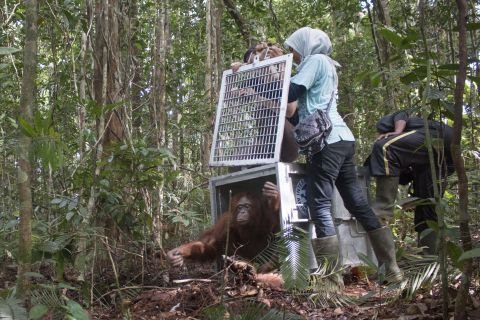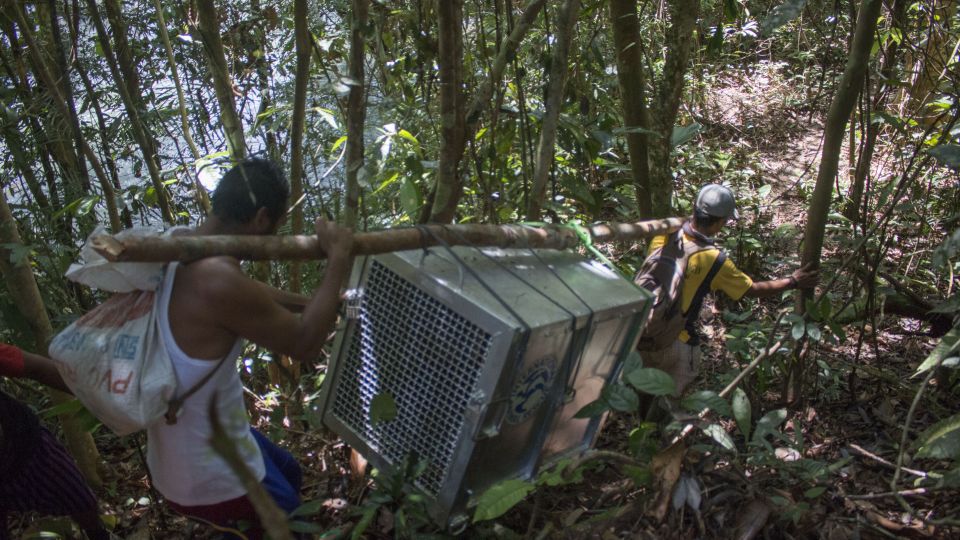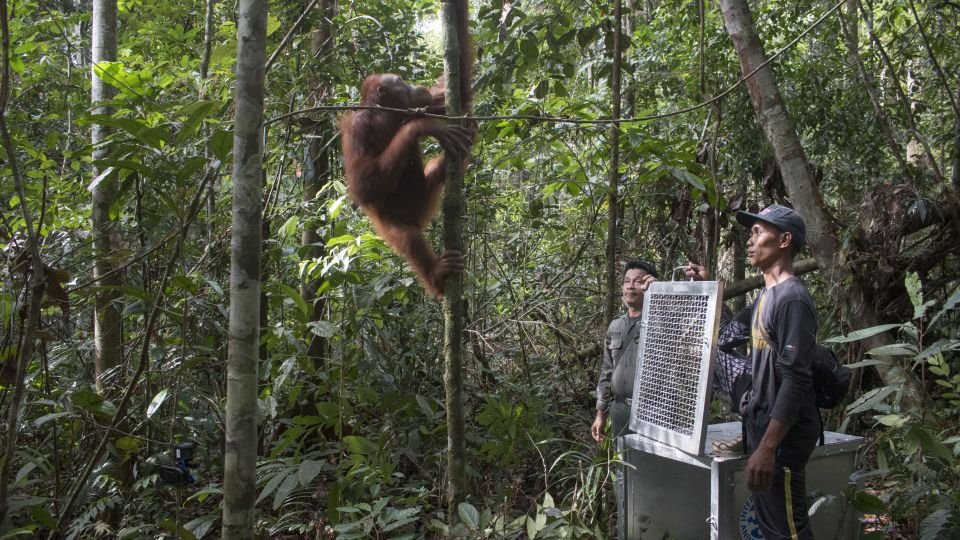
The great apes were released into the Bukit Baka Bukit Raya National Park (BBBR NP) by our team in Indonesia, in cooperation with the Institute for Natural Resources Conservation (BKSDA) and the National Park.
The orangutans named Amin and Shila were rescued several years ago by IAR and the BKSDA. Male Amin was rescued from land belonging to mining company PT Karya Utama Tambang (KUT) on 7 March 2013. He was about two years old and being kept by one of the mine workers. However, the man learned that it was illegal to keep an orangutan and informed the BKSDA in Ketapang so that the animal could be handed over.
When the rescue team found Amin he was in a very alarming condition with a chain around his neck. The owner claimed to have first put the chain around the orangutan’s waist but then moved it to his neck when he grew bigger. Our medical team found a number of scars on various parts of Amin’s body.
Shila is a female orangutan and now seven years old. She was brought in to our centre on 21 November 2014 by the local group Yayasan Kobus after being rescued from Monterado Village.

The two orangutans underwent rehabilitation at our Conservation Centre in Ketapang. During this time they learnt basic survival skills such as climbing, feeding and making a nest to sleep in each night.
Prior to release the medical team checked thoroughly that the health and natural behaviour of the orangutans made them suitable candidates for reintroduction. In the last stage before release, they were moved to a special island and data was collected on their behaviour. “The data on the orangutans revealed very positive results. They are adept at climbing, feeding and nesting. They are healthy and displaying no abnormal behaviour. This means they are ready to be released and survive in the wild,” said Dr Sulhi Aufa, medical coordinator.
The release team left the centre in Ketapang early on Wednesday 7 June and arrived at the National Park the following afternoon. The journey had taken 17 hours by car, followed by a boat ride of one hour and then four hours on foot. To reduce the orangutans’ stress levels, they were put into a habituation cage for one night to rest. They were released the following morning, on Friday 9 June, at a pre-determined release site.
Since Amin and Shila are both rehabilitated orangutans, a team trained by IAR will monitor the two orangutans for the next one to two years. The team is made up of people from villages buffering the park. They observe the orangutans from the moment they wake up until they build a nest and go back to sleep at night.

“These monitoring activities are carried out to ensure the orangutans are thriving in the wild. The team will call in the vets if they are seen to be sick, injured or losing condition,” said Dr Adi Irawan, Operations Manager.
Bukit Baka Bukit Raya National Park was chosen as a place of release because its status as a National Park can guarantee the safety of the animals in it. In addition, the condition of the forest in the park is still good and there is abundant food for orangutans to feed on, as was confirmed by a survey we carried out in 2011.
Our Conservation Centre currently houses more than 100 orangutans and it is estimated that the number will continue to rise in line with habitat loss through forest clearance for plantations and other large scale agricultural activity. This also makes it increasingly difficult to find safe release sites.
“The rehabilitation process takes a long time and the funds and effort it requires are considerable. The length of the process depends on each individual. Some are quick to learn, some take longer, “said Karmele Sanchez, Programme Director.
We have the chance to expand its centre by purchasing an additional 64 acres of forest adjacent to its existing site. This would increase the size of the centre by 20% and provide extra space to rehabilitate more orangutans like Amin and Shila. It would also protect the forest from clearance for large-scale agricultural or industrial use.
“We are urging the public to support our Forest Fund,” said Alan Knight, Chief Executive. “We have the opportunity to purchase a piece of forest where we can rehabilitate more orangutans and give them a second chance of freedom back in the forest. What could be better than that?
“You only have to watch Amin’s and Shila’s long journey back to the forest to appreciate the vital importance of our work for each individual orangutan we rescue and for the survival of this Critically Endangered species as a whole.”

